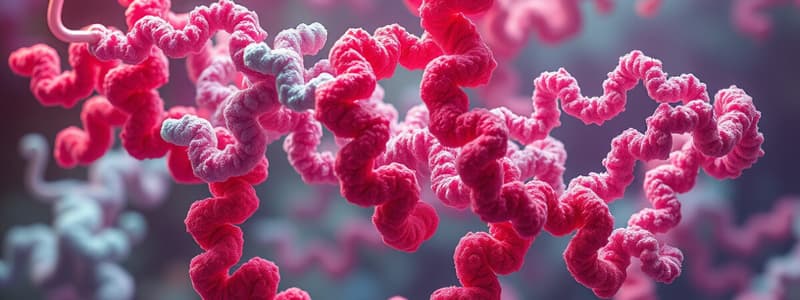Podcast
Questions and Answers
What is one of the key functions of glycine?
What is one of the key functions of glycine?
- Decreases glycogen storage
- Increases muscle degeneration
- Enhances sugar cravings
- Promotes a healthy prostate (correct)
Which amino acid is primarily associated with muscle tissue maintenance?
Which amino acid is primarily associated with muscle tissue maintenance?
- Isoleucine
- Histidine
- Glycine
- Glutamine (correct)
What function is associated with isoleucine?
What function is associated with isoleucine?
- Stabilizing blood sugar levels (correct)
- Production of white blood cells
- Repairing damaged tissue
- Treatment of schizophrenia
Which condition is histidine specifically used to treat?
Which condition is histidine specifically used to treat?
Glutamine is known for decreasing cravings for which nutrient?
Glutamine is known for decreasing cravings for which nutrient?
What is one of the primary functions of cysteine?
What is one of the primary functions of cysteine?
Which function is associated specifically with glutamic acid?
Which function is associated specifically with glutamic acid?
How does cysteine affect the aging process?
How does cysteine affect the aging process?
Which of the following conditions can glutamic acid be used to treat?
Which of the following conditions can glutamic acid be used to treat?
Which statement about the functions of cysteine is true?
Which statement about the functions of cysteine is true?
What is the primary function of amino acids in the body?
What is the primary function of amino acids in the body?
Which component of an amino acid differentiates it from others?
Which component of an amino acid differentiates it from others?
How many amino acids serve as the building blocks of proteins?
How many amino acids serve as the building blocks of proteins?
What is the significance of the chiral carbon in amino acids?
What is the significance of the chiral carbon in amino acids?
Which part of the amino acid structure provides its acidic properties?
Which part of the amino acid structure provides its acidic properties?
What is one of the primary functions of leucine?
What is one of the primary functions of leucine?
Which amino acid is important for collagen production?
Which amino acid is important for collagen production?
Which function is associated with methionine?
Which function is associated with methionine?
What role does lysine play in the human body?
What role does lysine play in the human body?
Which of the following is a benefit of leucine?
Which of the following is a benefit of leucine?
What is a function of lysine related to the immune system?
What is a function of lysine related to the immune system?
Methionine contributes to which of the following?
Methionine contributes to which of the following?
Which statement about leucine is incorrect?
Which statement about leucine is incorrect?
Which amino acid is primarily involved in neurotransmitter production?
Which amino acid is primarily involved in neurotransmitter production?
What is a major function of Proline?
What is a major function of Proline?
Which of the following conditions is NOT treated with Phenylalanine?
Which of the following conditions is NOT treated with Phenylalanine?
What role does Serine play in the body?
What role does Serine play in the body?
Which amino acid works with Vitamin C to promote healthy connective tissue?
Which amino acid works with Vitamin C to promote healthy connective tissue?
Flashcards are hidden until you start studying
Study Notes
Proteins: Structure and Function
- Proteins are essential macromolecules composed of amino acids, serving various roles in biological systems.
- There are over 300 amino acids, but 20 are standard, forming the building blocks of proteins.
- Amino acids consist of an amino group, carboxyl group, hydrogen atom, and an R-group (side chain) that differentiates each amino acid.
Structure of Amino Acids
- The R-group determines the unique properties of each amino acid, influencing protein structure and function.
- Amino acids are linked by peptide bonds to form peptides and polypeptides, which fold into functional proteins.
Functions of Key Amino Acids
- Alanine: Vital for nitrogen transfer from tissues to the liver, influencing metabolic processes.
- Cysteine: Acts as an antioxidant, protects against toxins and radiation, and contributes to muscle maintenance and fat burning.
- Glutamic Acid: Serves as an excitatory neurotransmitter; plays a role in sugar and fat metabolism and neurological health.
- Glutamine: Supports muscle tissue integrity, cognitive function, and manages sugar cravings.
- Glycine: Helps with muscle degeneration, promotes healthy prostate and immune function, and facilitates tissue repair.
- Histidine: Important for red and white blood cell production, involved in immune function and treatment of various ailments.
- Isoleucine: Essential for hemoglobin synthesis, blood sugar regulation, and energy balance.
- Leucine: Promotes muscle growth and recovery, assists in glucose metabolism, and enhances muscle protein synthesis.
- Lysine: Critical for calcium absorption, collagen formation, immune response, and neurotransmitter production.
- Methionine: Influences keratin production for skin and hair health, aids in fat metabolism and detoxification.
- Phenylalanine: Precursor for norepinephrine production, affecting mood, alertness, and cognitive functions.
- Proline: Key for collagen formation and wound healing, enhances skin quality, and works with Vitamin C for connective tissue health.
- Serine: Necessary for fat metabolism, muscle growth, and immune system maintenance.
Summary
- Understanding the structure and function of amino acids is crucial for grasping their role in biological processes and overall health.
- Each amino acid has distinct functions, contributing to metabolic pathways, structural integrity, and physiological support in the body.
Studying That Suits You
Use AI to generate personalized quizzes and flashcards to suit your learning preferences.




